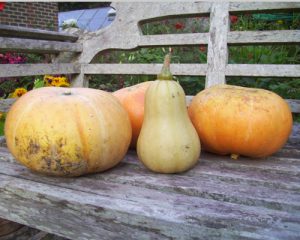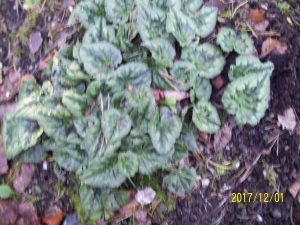October Gardening
by Ewshot Gardener in association with Church Crookham Garden Society

Pumkins and Squash can be stored in a shed once they sound hollow when you tap them
Here we are, at the beginning of Autumn, the roar of leaf blowers and the scratch of rakes filling the air. I do hope those leaves will be composted to make leaf mould!
Most of the harvesting is done: potatoes lifted and stored cool and dark in hessian sacks, apples stored in newspaper on trays, carrots and beetroot are more difficult, but will not stand frost – why not pickle the beetroot? Pumpkins and squash can be stored in a shed or garage once they sound hollow when you tap them.
Now let us start on next year’s produce by sowing broad beans, planting overwintering onions and shallots, and sowing sweet pea seeds in a cold frame or unheated greenhouse. Plant Spring bulbs (except tulips, leave them until November to reduce the risk of ‘tulip fire’)
Now is the time to divide herbaceous perennials, move small shrubs and plant bare-rooted young trees (these will need firm support)
It is tempting to tidy all top growth of plants once they finish flowering:
DO rake up and dispose of diseased leaves from below roses and apple trees; DO cut out fruited branches of blackberries and their relations so you can tie in new growth; DO reduce the height of Buddleias, Lavatera and Sambuca to reduce wind rock and snow damage BUT LEAVE the main pruning until March. Most herbaceous plants can be cut own but some have seed heads useful to birds. DON’T cut down Penstemons, Gaura or hardy Fuchsias until late Spring to protect the plant from frost; similarly, leave Hydrangea flowers on the bush until March to protect next year’s flower buds.
Now you must drag dead foliage from your pond, my unfavourite job, but if you don’t, the pond will become too fertile for clear water and will eventually turn into dry land!
Frogs toads, newts, hedgehogs, slow worms and grass snakes are all great eaters of slugs so I would like them to stay in my garden. An untidy heap of sticks and leaves in a quiet corner will give them somewhere to hibernate. Do, please, remember this before lighting a bonfire!
The pigeons will be after your Brussels sprouts and broccoli so protect the plants with net. Enjoy the sight of squirrels, magpies and jays burying acorns, chestnuts and hazelnuts in your perfect lawn!
To keep that perfect lawn, maintenance continues with scarification, aeration and Autumn feed. I tend to leave the last mowings down to help the worms and the soil structure; it can look a bit messy though!
Autumn sunshine brings out the best in ornamental grass seed heads and maple and beech leaves before they fall. Spare some time to stand (or sit) and stare.
Gardens to visit this month
Chawton House Library open for NGS on 22nd October
Winkworth Arboretum for Autumn colour open for NGS on 1st October, open National Trust all year 10am-6pm, except Christmas.
September Gardening
by Ewshot Gardener in association with Church Crookham Garden Society
September is a good time to look around your garden, taking photographs to remind you of both the triumphs and the disasters; for example, the Crocosmias and Erigerons in my herbaceous border fell over in July and crushed all beneath, so I need to move them in October to somewhere less shady (or give more support!).
The year is far from over and chrysanthemums, asters and dahlias will go on flowering so long as you feed and dead-head them. Beans, sweetcorn and main potatoes can be harvested, but leave pumpkins and squashes on the plant to ripen.

Here is an Erigeron still standing. It is popular with the bees.
I grow Autumn raspberries which go on cropping into October and, of course, apples and pears can be harvested and stored somewhere cool and frost-free as soon as they pick easily when you lift and turn.
I am going to take cuttings of my favourite fuchsias, pelargoniums and penstemons to overwinter under cover. If I lifted the whole plants, there would be no room in the house or greenhouse! Collect seeds from other plants and dry them before storing in paper envelopes (or swapping with friends).
September is also a time to start planting – daffodils need to go in now but tulips can wait until November.
Onions and shallots can be planted for overwintering.
Don’t forget to protect Brassicas from pigeons!
If your lawn is your pride and joy, then give it an Autumn feed (low nitrogen reduces soft growth and strengthens roots), scarify and aerate. It has not been a good year for lawns in Ewshot, has it?
To give a tidy outline for the Winter, clip deciduous hedges and give a second clip to the soft growth of cypress and yew.
This is the time many gardeners net their ponds to prevent leaves getting in, although one needs to consider wildlife access when doing so.
Here are some 2017 dates of interest
• 10th September Bramdean House near Alresford is open on for the National Gardens Scheme.
• 16th September Church Crookham Garden Society Show at Crookham memorial Hall, Sandy Lane (free entry, for classes see www.ccgsoc.org.uk)
• 17th September Harvest Festival at Ewshot
• 7th October Harvest Supper at Crookham Memorial Hall (see ccgsoc.org.uk for details)
Here is an Erigeron still standing. It is popular with the bees.
January Gardening Tips
Reasons to be Cheerful
The shortest day has been and gone and the daily period of light has, almost imperceptibly, increased. The infra-red wavelengths penetrate the soil and activate enzymes, via chemicals called phytochromes, that start seeds and dormant plants growing.
Witch hazel, Sarcococca, Daphne odora and mahonia are just some of the scented lowers you can enjoy now. Wintergreen ferns give a wonderful textured foliage effect in sheltered shady spots, so do the leaves of Cyclamen hederafolia and Pulmonaria. Cyclamen coum flowers in early spring and combines well with winter aconites or snowdrops. (The peak flowering time for most snowdrops is February, but varieties like Galanthus elwessii, G.nivalis and G.woronowii are earlier.)

Cyclamen
Jobs to do
Kitchen garden Prune gooseberries, red and white currants to maintain an open centred bush with 8 – 10 main branches – this avoids mildew. Prune last year’s growth by half. Finish winter pruning of fruit trees (except plums and cherries). Continue harvesting winter vegetables like parsnips and Brussels sprouts.
Ornamental garden Start pruning wisteria. The current season’s growth, tamed in July, should be cut back to 2-3 buds from old wood. If the old wood is tangled or overgrown, cut it back to a fork or side branch, maybe back to ground level.
Start cutting old leaves from ornamental grasses to make room for new growth. Also cut off old leaves on hellebores to expose the flowers, unless grown for foliage effect.
Prune winter jasmine when the flowers fade.

Iris unguiculata
Plant deciduous hedges like beech, hornbeam, blackthorn and hawthorn.
Indoors (more…)